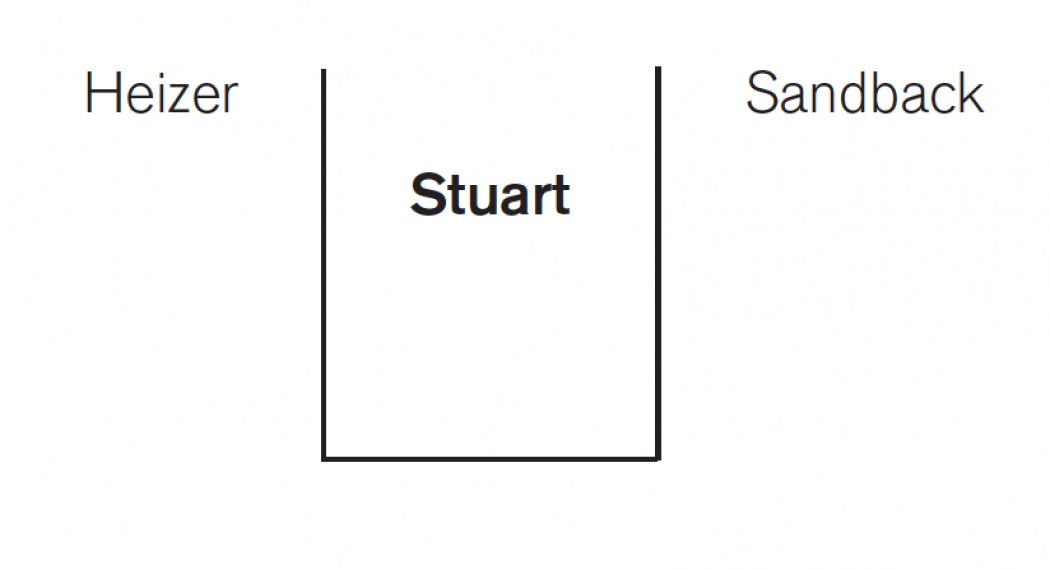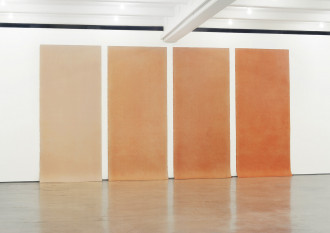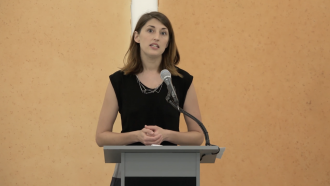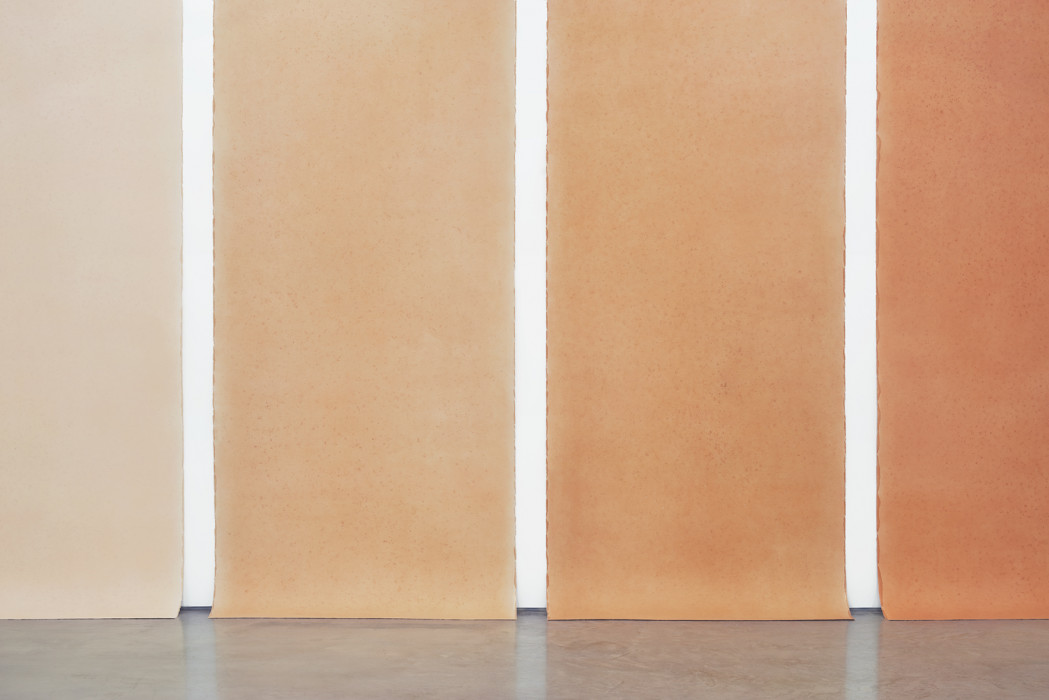Michelle Stuart
May 5, 2017–November 27, 2023, Dia Beacon
Overview
In 1972 Michelle Stuart began work on a group of large paper scrolls that incorporate frottage (a rubbing technique) with graphite to capture the uneven and unique topography of the earth’s surface. The largest example from this group of works, Sayreville Strata Quartet (1976) presents the colors and textures of an abandoned brick quarry in Sayreville, New Jersey, on four panels of paper. Substituting graphite for samples from four layers of the quarry’s red soil, Stuart pressed the earth directly onto sheets of paper laid across the site to make this work. Her monochrome rubbings of the 1970s simultaneously challenged the hard-edged aesthetic of Minimalist painting and its industrial materials, as well as the relationship between drawing and the artist’s hand. Moreover, breaking with the monumental scale of early Land art, these rubbings explore a physical connection to site and the product of memory.
In 1972 Michelle Stuart began working on a group of large-scale rubbings on paper scrolls, which used graphite or soil as pigment to capture the uneven and unique terrain of the earth’s surface. The largest example from this group of works, the four-part Sayreville Strata Quartet (1976), presents the colors and textures of an abandoned brick quarry in Sayreville, New Jersey.
Stuart has had a lifelong interest in documenting the specificities of land formations. Early in her career she worked briefly as a topographical draftsperson for the United States Army Corps of Engineers. The experience in mapmaking was formative for the artist who explores the intersection of social and physical histories of place. Throughout the 1970s Stuart used muslin-backed rag paper—a sturdy medium that she discovered through cartography—to create complex monochromatic renderings, which are at once visual abstractions and figurative indices of site.
Each of the four panels of paper in Sayreville Strata Quartet is infused with soil excavated from a different layer of the quarry’s earth. To create the work, Stuart laboriously ground pebbles and dirt directly into the paper’s fibrous weave, building up both color and texture. In 1975 the art critic Lawrence Alloway wrote that Stuart’s rubbings represented “an expansion of drawing into the scale, both physical and conceptual, of painting and sculpture.” Spilling off the walls and onto the floor, her dense scrolls unfold into the viewer’s space, while simultaneously challenging the hard-edged aesthetic of Minimalist painting and its industrially manufactured materials.
The gently scarred surfaces of Sayreville Strata Quartet’s panels map Stuart’s repetitive drawing process onto the site’s geological gradations—revealed by the mining that shaped the quarry. This temporal interweaving creates a diachronic record of site that is archaeological in impulse. As Alloway argued a decade later, Stuart’s rubbings have a “geological sense of time” that address an “imagery of the duration of culture.” New Jersey’s postindustrial landscapes were a generative source for many artists associated with Land art. Robert Smithson, in particular, mined the state’s incongruous and unstable landscapes for his many non-site projects. However, breaking with the monumental scale of early Land art, Stuart’s intimately rendered rubbings explore a physical connection to site and the production of memory.

Sayreville Strata Quartet, 1976
Earth on muslin-backed rag paper
Dia Art Foundation
Michelle Stuart was born in Los Angeles in 1933. After attending the Chouinard Art Institute in Los Angeles from 1951 to 1952, Stuart worked as a topographical draftsperson for the United States Army Corps of Engineers. Soon after, she moved to Mexico to work as an assistant to Diego Rivera. After moving to New York City in 1958, Stuart continued to explore the unique and varied character of the earth’s topography. Her exhibitions in the later 1960s and early 1970s reflect her interest in capturing these distinct surfaces through various mediums like sculpture and photography, and drawing techniques such as frottage. Stuart has been the subject of many exhibitions, most recently at the Bronx Museum of the Arts (2016) and Santa Barbara Museum of Art (2014), and her work has been acquired by major museums in the United States and Europe. She has been the recipient of numerous awards, including four grants from the National Endowment for the Arts (1975, 1977, 1980, and 1989), a John Simon Guggenheim Foundation Fellowship (1975), American Academy in Rome Residency (1995), and most recently the Peter S. Reed Foundation Grant for Painting (2009). Stuart currently lives and works in New York City, Amagansett, New York, and Carpinteria, California.
Artist
Michelle Stuart
Michelle Stuart was born in Los Angeles in 1933. She currently lives and works in New York City, Amagansett, New York, and Carpinteria, California.
Selected Works on View

Michelle Stuart
Sayreville Strata Quartet, 1976
Go to Sayreville Strata Quartet pageExplore


